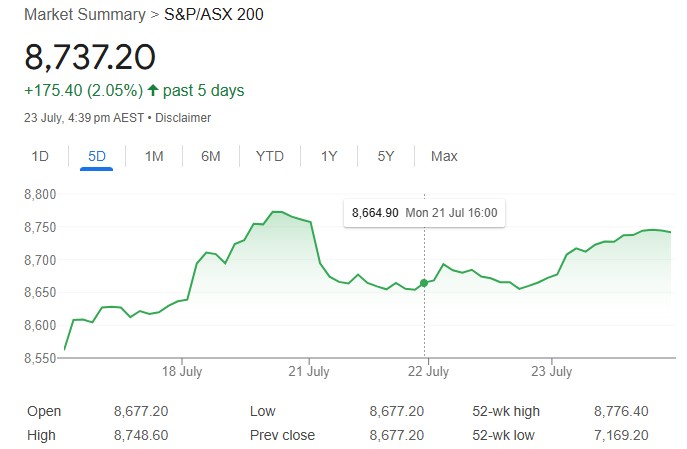| Name | Price | Change | % Chg |
|---|---|---|---|
| Dow | 45,010.29 | 507.85 | 1.14% |
| S&P 500 | 6,358.91 | 49.29 | 0.78% |
| Nasdaq | 21,020.02 | 127.33 | 0.61% |
| VIX | 15.37 | -1.13 | -6.85% |
| Gold | 3,398.40 | 0.8 | 0.02% |
| Oil | 65.44 | 0.19 | 0.29% |
OVERVIEW OF THE US MARKET
The S&P 500 hit all-time highs on news reports the EU and the US are progressing toward an agreement that would set a 15% tariff for most products.
Stock indexes started the day higher after the Japan pact was disclosed late Tuesday, then climbed to new highs after reports that the European Union is negotiating a trade agreement with the Trump administration that would see the bloc accept 15% tariffs on most exports to the U.S.
During Wednesday’s trade, the Dow Jones Industrial Average gained 1.1%, or 507.85 points, to close at 45010.29. The S&P 500 rose 0.8% and the Nasdaq composite added 0.6%, also hitting a record and closing above 21,000 for the first time.
The rally in equity markets came on the back of statements from President Trump who said that the U.S. will levy 15% tariffs in Japan, with tariffs at the same level on the country’s auto industry. Japan will also invest $550 billion in America, and the U.S. will receive 90% of the profits from the investments, he said. The whirlwind of trade deals has raised investors’ hopes that the Trump administration will sign more agreements with trading partners before the Aug. 1 deadline for the president’s tariffs to kick in. The U.S. announced deals with the Philippines and Indonesia on Tuesday.
In late hours, Alphabet Inc. reported better-than-expected revenue but said capital expenditures will be higher than previously forecast. Tesla Inc.’s earnings fell short of Wall Street’s estimates.
Tesla’s net income plunged 16% in the second quarter, marking another quarter of steep declines at the company as automotive sales continue to fall. The company’s second-quarter revenue declined after a drop in automotive deliveries, which were down 13.5% from a year earlier. Tesla reported $22.5 billion in revenue for the quarter, down 12% compared with the same period last year. Revenue from the company’s automotive business fell 16%. The energy business fell 7%.
Google’s parent company reported a 14% jump in year-over-year revenue, driven by growth in its cloud and search divisions that was tempered by heavy spending on artificial intelligence. Alphabet beat expectations and said it was lifting its 2025 capex budget by $US10 billion ($15 billion) to about $US85 billion amid surging demand for its cloud products and services. The firm had record sales of $96.4 billion in the second quarter but also said capital expenditure expectations for the year would increase by 13% to about $85 billion. That compares with $52.5 billion in 2024. Google’s results were the first in a series of quarterly tech earnings, with Microsoft, Apple, Amazon and Meta Platforms reporting next week. Investors are keeping a close watch on spending levels at most of the biggest companies, which have ballooned as they race to stay ahead in an escalating AI arms race.
International Business Machines’ investments in artificial intelligence are helping it stay agile as customers continue to shift their spending to keep up with a shifting macroeconomic environment. Revenue rose 8% to $16.98 billion in the second quarter. Analysts surveyed by FactSet forecast revenue of $16.59 billion. Software sales were driven by 16% growth in its hybrid cloud revenue, which includes its Red Hat cloud-management, and increased at a higher rate than the prior quarter. Automation revenue also increased 16%.
The EU and the US have accelerated talks over the past weeks to avoid a full-blown trade war. Bloomberg News reported that European officials are optimistic that a deal can be reached, but negotiations remain fluid.
Equities will beat Treasuries and deliver better volatility-adjusted returns as the reporting season ramps up in the coming weeks, according to nearly two-thirds of the 102 participants in a poll conducted July 10-17. The positive outlook for stocks continues to be underpinned by technology, and the sector is poised to perform strongest this earnings season, respondents noted.
OVERVIEW OF THE AUSTRALIAN MARKET

The S&P/ASX 200 finished higher despite mixed sector performance, as a surge in materials and energy stocks offset ongoing financials pressure.
The broad index advanced 0.69% to 8,737.2, nearing last Friday’s record close within 0.1%. The All Ordinaries rose 60.2 points, or 0.67%, to 9,001.4, while the Small Ords Index gained 0.52% to 3,381.3, showing broad-based strength. The Australian dollar strengthened 0.15% to 0.6565, buoyed by positive US futures, with the S&P 500 up 0.27% to 6,364.0.
Investors digested corporate updates on Wednesday, with some reflecting resilience amid tariff concerns from Trump’s 30% threats on EU and Mexico goods due August 1. Materials stocks led gains, with Fortescue Metals up 2.3%, Rio Tinto gaining 1%, and BHP advancing 0.9% as iron ore futures hit $US105.65—a five-month high—driven by China’s Tibet dam project. Energy rallied 0.83%, led by Woodside Energy’s 1.5% rise after strong Q2 production, despite oil weakness.
Financials rose 0.79%, with Insurance Australia Group jumping 3.2% after an UBS upgrade, though the sector remains volatile. Telix Pharmaceuticals plunged 15.1% to nine-month lows after a US SEC subpoena, while Paladin Energy tumbled 11.3% due to missed FY26 guidance. Whitehaven Coal surged 6.5% as China cracked down on coking coal overproduction, and homebuilders like James Hardie gained 5.1%.
The market’s strength signals broadening leadership beyond financials, with the Energy Index hitting a nine-month high and Materials up 6.2% over five days, breaking above its 200-day moving average. Today’s strong PMI flash data for Jun, alongside the new Japan-US trade deal and potential EU agreement add optimism further.

